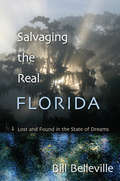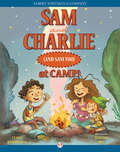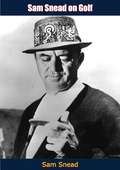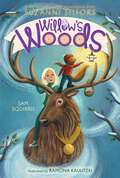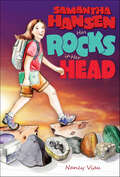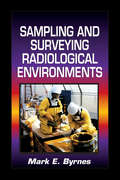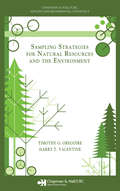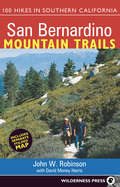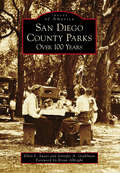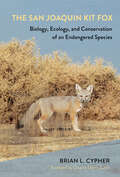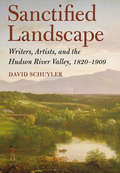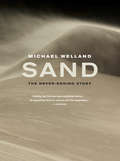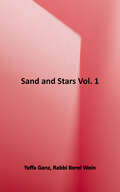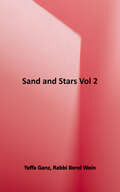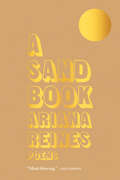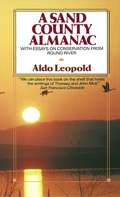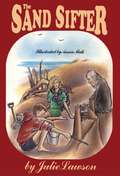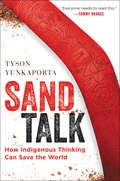- Table View
- List View
Salvaging the Real Florida: Lost and Found in the State of Dreams
by Bill BellevilleModern life has a tendency to trap people in cubicles, cars, and cookie-cutter suburbs. Thankfully, someone comes along now and then to remind us of the beauty that presents itself when we turn off the information feeds and turn away from the daily grind. Bill Belleville’s enchanting Salvaging the Real Florida invites readers to rediscover treasures hidden in plain sight. Join Belleville as he paddles a glowing lagoon, slogs through a swamp, explores a spring cave, dives a "literary" shipwreck, and pays a visit to the colorful historic district of an old riverboat town. Journey with him in search of the apple snail, the black bear, a rare cave-dwelling shrimp, and more. Everywhere he goes, Belleville finds beauty, intrigue, and, more often than not, a legacy in peril. Following in the tradition of John Muir, William Bartram, and Henry David Thoreau, Belleville forges intimate connections with his surroundings. Like the works of Marjory Stoneman Douglas and Archie Carr, his evocative stories carry an urgent and important call to preserve what is left of the natural world.
Sam and Charlie (and Sam Too) at Camp!
by William Owl Leslie KimmelmanBest friends Sam and Charlie are headed to sleepaway camp for the first time! Each day brings something new--from swimming and nature hikes to camp songs and FOAM day! At camp, Sam and Charlie learn the importance of shomrei adamah, taking care of the earth, and taking care of friendships, new and old.This is a fixed-format ebook, which preserves the design and layout of the original print book.
Sam Snead on Golf
by Sam SneadEver since Sam Snead was a kid, swishing a hickory stick at acorns, he has been talking about golf the way he plays it…in a natural, easy-going style.Now—the fabulous “Slammin’” Sam Snead demonstrates through word and picture, how you can swing into a relaxed game, lower scores and play better golf.Sam Snead is known as the golfer with the greatest swing in the history of the game. Here, his famous swing is captured in a series of action photos that give you a close-up look at each important motion.All of the difficulties suffered by the “weekend golfer”—erratic putting, poor chip shots, topped shots, shanking, weak pitch shots—are analyzed by Snead from fault to cause to cure. He explains what is wrong, why it happens and how you can correct it. Your game is bound to improve once you “blueprint” your mistakes the Sam Snead way.
Sam Squirrel (Willow’s Woods #1)
by Suzanne SelforsThe great-granddaughter of Mother Nature teams up with a squirrel to start the spring season in this first book in the charmingly whimsical chapter book series from bestselling and award-winning author Suzanne Selfors.Willow has agreed to house-sit while her grandmother, Mother Nature, is on vacation. Willow thinks it&’s going to be as easy as watering a fern and feeding a cat, but when she arrives, she realizes her grandmother has left a long to-do list of difficult tasks like dusting the wings of a sleeping bat family, repairing the broken windows of a rabbit&’s greenhouse, and ending winter. Ending winter? In her eagerness to take a vacation, Mother Nature forgot to catch the unruly North Wind for its long nap. So, even though it&’s the first day of spring, the entire land is covered in ice and snow. If the snow doesn&’t melt, allowing the spring grass to grow, the critters of the Quiet Woods will surely go hungry. With the help of Sam Squirrel and an elk prince named Errol, will Willow be able to catch the unruly North Wind to preserve the natural balance her grandmother entrusted her with?
Sam the Man & the Rutabaga Plan
by Amy June Bates Frances O'Roark DowellSam the Man has a new school project. He’s got to “babysit” a vegetable in this second hilarious chapter book in a new series from Frances O’Roark Dowell.Sam the Man is back, and he needs a NEW plan. Sam has already solved a chicken problem, but this time, he’s having rutabaga issues. Rutabaga? Yes, Rutabaga. You see, Sam thought he was quite clever, missing school while his classmates were picking out their vegetable for a two-week science project. But, instead of being able to skip the project, he gets stuck with the vegetable that no one else wanted: the rutabaga! What even is this thing? It’s dirty and kinda purple, and it does not look like something Sam would ever eat. Sam the Man is not a vegetable man to begin with, and he doesn’t think he’ll ever be a rutabaga man. But after drawing a little face on it, he starts to grow fond of the curious veg. Then it dawns on him that vegetables don’t last forever…so he changes his plan: he has to keep this rutabaga happy—and rot-free—for as long as he can. To do that, he’ll have to make the best dirt possible. All he needs is a little help from nature, and, of course, his chickens!
Samantha Hansen Has Rocks in Her Head
by Nancy ViauBig rock collector. Big mouth. BIG problem! Ten-year-old Samantha Hansen loves science, especially rocks and minerals. Her family is planning a dream-come-true trip to the Grand Canyon where Sam will finally see the “biggest chunk of sedimentary rock on the planet.” But there’s a problem—Sam has a temper. She works hard to stay out of trouble, but it’s not easy because she has to deal with a bossy sister, a busy mom who’s obsessed with birthdays, and a playground bully who calls her a science freak. Will Sam survive the class cave trip, a rocky talent show, and a visit to the principal's office? Will her lists of science facts and thoughts about her world help her calm down? Will she ever get up the nerve to ask her mom about her dad? Filled with laugh-out-loud dialogue, school drama, and poignant family moments, Samantha Hansen is sure to delight and inspire. This kid ROCKS!
The Samoyed Dog (Learning About Dogs)
by Charlotte WilcoxIntroduces the history, development, uses, and care of this white dog from the far North.
Sampling and Surveying Radiological Environments
by Mark E. ByrnesPrivate landowners or Federal Agencies responsible for cleaning up radiological environments are faced with the challenge of clearly defining the nature and extent of radiological contamination, implementing remedial alternatives, then statistically verifying that cleanup objectives have been met. Sampling and Surveying Radiological Environments provides the how-tos for designing and implementing cost effective and defensible sampling programs in radiological environments, such as those found in the vicinity of uranium mine sites, nuclear weapons production facilities, nuclear reactors, radioactive waste storage and disposal facilities, and nuclear accidents. It includes downloadable resources that walk you through the EPA's Data Quality Objectives(DQO) procedures and provides electronic templates you can complete and print. Sampling and Surveying Radiological Environments addresses all of the major topics that will assist you in designing and implementing statistically defensible sampling programs in radiological environments, including: Summary of the major environmental laws and regulations that apply to radiological sites, and advice on regulatory interfacing· Internet addresses where you can find regulations pertaining to each States Theory of radiation detection and definitions of common radiological terminologyStatistics and statistical software that apply to the environmental industry Details on commercially available radiological instrumentation and detection systems Building decontamination and decommissioning, radiological and chemical equipment decontamination procedures, and tank/drum/remote characterizationStandard operating procedures for collecting environmental media samples Guidance on sample preparation, documentation, and shipment Guidance on data verification/validation, radiological data management, data quality assessment (DQA)
Sampling Rare or Elusive Species: Concepts, Designs, and Techniques for Estimating Population Parameters
by William ThompsonInformation regarding population status and abundance of rare species plays a key role in resource management decisions. Ideally, data should be collected using statistically sound sampling methods, but by their very nature, rare or elusive species pose a difficult sampling challenge. Sampling Rare or Elusive Species describes the latest sampling designs and survey methods for reliably estimating occupancy, abundance, and other population parameters of rare, elusive, or otherwise hard-to-detect plants and animals. It offers a mixture of theory and application, with actual examples from terrestrial, aquatic, and marine habitats around the world. Sampling Rare or Elusive Species is the first volume devoted entirely to this topic and provides natural resource professionals with a suite of innovative approaches to gathering population status and trend data. It represents an invaluable reference for natural resource professionals around the world, including fish and wildlife biologists, ecologists, biometricians, natural resource managers, and all others whose work or research involves rare or elusive species.
Sampling Strategies for Natural Resources and the Environment (Chapman & Hall/CRC Applied Environmental Statistics)
by Timothy G. Gregoire Harry T. ValentineWritten by renowned experts in the field, Sampling Strategies for Natural Resources and the Environment covers the sampling techniques used in ecology, forestry, environmental science, and natural resources. The book presents methods to estimate aggregate characteristics on a per unit area basis as well as on an elemental basis. In addition to comm
San Bernardino Mountain Trails
by John W. Robinson David Money HarrisAfter more than 30 years in print, San Bernardino Mountain Trails remains the bible for Southern California hikers. This updated guide contains new trips as well as old favorites, covering 100 hikes that traverse San Bernardino National Forest, the Santa Rosa Mountains, and San Jacinto Mountains. Includes difficulty ratings, season recommendations, elevation profiles and other essential info, as well as historical photos and descriptions, including early mining operations and pioneer cabins. Includes separate folded map.
San Diego County Parks: Over 100 Years (Images of America)
by Brian Albright Ellen L. Sweet Jennifer A. GrahlmanFrom its earliest park in 1913, the County of San Diego has more than 100 years of serving the public with unique park and recreational experiences while preserving significant natural and cultural resources. Officially, the San Diego County Board of Supervisors established the Department of Recreation in 1946. Today, the department manages over 50,000 acres of parks, campgrounds, trails, recreation centers, sports complexes, and ecological and open-space preserves. The county covers an area that includes coastline, mountains, deserts, lakes, lagoons, and other habitats�it is the nation�s most biologically diverse county�and the department�s properties mirror this biodiversity. They also contain sites that reveal the county�s history: Mexican-era ranchos, an overland stage station, remnants of an early gristmill, Victorian mansions, traces of flume systems, Depression-era construction projects, an 1887 boathouse, and parks that reflect the advent of early automobile tourism.
San Diego's North Park
by North Park Historical SocietyHip and historic, North Park fascinates with its commercial energy and Craftsman charm. The community has always embodied an enterprising spirit. In the 1870s, cronies of Alonzo Horton mapped neighborhoods north of Balboa Park in a patchwork of individual subdivisions. Four decades later, John Spreckels's streetcars finally brought investors, residents, and shopkeepers, creating San Diego's slice of Bungalow Heaven. Baseball great Ted Williams played on North Park's fields, and tennis star Maureen Connolly trained on its courts. The local shops served as a regional commercial center after World War II, and the Toyland Parade attracted 300,000 spectators. Although decades of decline followed the exciting 1950s, North Park is flourishing again in a renaissance initiated by the restoration of the elegant North Park Theatre in 2005. This pictorial history tells the classic story of a boom, bust, and boom.
The San Joaquin Kit Fox: Biology, Ecology, and Conservation of an Endangered Species
by Brian L. CypherThe San Joaquin Kit Fox introduces readers to a small wild canid that occupies a prominent position in ongoing conservation battles. Native to central California, where land is in high demand for development purposes, the San Joaquin kit fox population has been significantly impacted by profound habitat loss. The species remains on the original US endangered species list issued in 1966, with dim prospects for recovery.To guide the work of researchers and conservationists, Brian L. Cypher synthesizes the biological and ecological data collected to date on this species and documents both historical and contemporary efforts to protect it. He details the species' evolutionary and taxonomic history, distribution and habitat preferences, mortality sources, and more. In doing so, he draws out the ever-changing relationship between San Joaquin kit foxes, people, and land use. Richly illustrated and accessible, The San Joaquin Kit Fox is a necessary reference for students, researchers, and conservationists looking to better understand this charismatic creature and others like it in order to better secure the futures of these species.
Sanctified Landscape: Writers, Artists, and the Hudson River Valley, 1820–1909
by David SchuylerThe Hudson River Valley was the first iconic American landscape. Beginning as early as the 1820s, artists and writers found new ways of thinking about the human relationship with the natural world along the Hudson. Here, amid the most dramatic river and mountain scenery in the eastern United States, Washington Irving and James Fenimore Cooper created a distinctly American literature, grounded in folklore and history, that contributed to the emergence of a sense of place in the valley. Painters, led by Thomas Cole, founded the Hudson River School, widely recognized as the first truly national style of art. As the century advanced and as landscape and history became increasingly intertwined in the national consciousness, an aesthetic identity took shape in the region through literature, art, memory, and folklore-even gardens and domestic architecture. In Sanctified Landscape, David Schuyler recounts this story of America's idealization of the Hudson Valley during the nineteenth and early twentieth centuries. Schuyler's story unfolds during a time of great change in American history. At the very moment when artists and writers were exploring the aesthetic potential of the Hudson Valley, the transportation revolution and the rise of industrial capitalism were transforming the region. The first generation of American tourists traveled from New York City to Cozzens Hotel and the Catskill Mountain House in search of the picturesque. Those who could afford to live some distance from jobs in the city built suburban homes or country estates. Given these momentous changes, it is not surprising that historic preservation emerged in the Hudson Valley-the first building in the United States preserved for its historic significance is Washington's Headquarters in Newburgh. Schuyler also finds the seeds of the modern environmental movement in the transformation of the Hudson Valley landscape. Richly illustrated and compellingly written, Sanctified Landscape makes for rewarding reading. Schuyler expertly ties local history to national developments, revealing the Hudson River Valley was so important to nineteenth-century Americans-and why it is still beloved today.
A Sanctuary of Trees: Beechnuts, Birdsongs, Baseball Bats, and Benedictions
by null Gene LogsdonAs author Gene Logsdon puts it, "We are all tree huggers." But not just for sentimental or even environmental reasons. Humans have always depended on trees for our food, shelter, livelihood, and safety. In many ways, despite the Grimm's fairy-tale version of the dark, menacing forest, most people still hold a deep cultural love of woodland settings, and feel right at home in the woods.In this latest book, A Sanctuary of Trees, Logsdon offers a loving tribute to the woods, tracing the roots of his own home groves in Ohio back to the Native Americans and revealing his own history and experiences living in many locations, each of which was different, yet inextricably linked with trees and the natural world. Whether as an adolescent studying at a seminary or as a journalist living just outside Philadelphia's city limits, Gene has always lived and worked close to the woods, and his curiosity and keen sense of observation have taught him valuable lessons about a wide variety of trees: their distinct characteristics and the multiple benefits and uses they have.In addition to imparting many fascinating practical details of woods wisdom, A Sanctuary of Trees is infused with a philosophy and descriptive lyricism that is born from the author's passionate and lifelong relationship with nature: "There is a point at which the tree shudders before it begins its descent. Then slowly it tips, picks up speed, often with a kind of wailing death cry from rending wood fibers, and hits the ground with a whump that literally shakes the earth underfoot. The air, in the aftermath, seems to shimmy and shiver, as if saturated with static electricity. Then follows an eerie silence, the absolute end to a very long life."Fitting squarely into the long and proud tradition of American nature writing, A Sanctuary of Trees also reflects Gene Logsdon's unique personality and perspective, which have marked him over the course of his two dozen previous books as the authentic voice of rural life and traditions.
Sand
by Michael WellandFrom individual grains to desert dunes, from the bottom of the sea to the landscapes of Mars, and from billions of years in the past to the future, this is the extraordinary story of one of nature's humblest, most powerful, and most ubiquitous materials. Told by a geologist with a novelist's sense of language and narrative, Sand examines the science--sand forensics, the physics of granular materials, sedimentology, paleontology and archaeology, planetary exploration--and at the same time explores the rich human context of sand. Interwoven with tales of artists, mathematicians, explorers, and even a vampire, the story of sand is an epic of environmental construction and destruction, an adventure in staggering scales of time and distance, yet a tale that encompasses the ordinary and everyday. Sand, in fact, is all around us--it has made possible our computers, buildings and windows, toothpaste, cosmetics, and paper, and it has played dramatic roles in human history, commerce, and imagination. In this luminous, kinetic, revelatory account, we do indeed find the world in a grain of sand.
Sand and Stars
by Berel Wein Yaffa GanzSand and Stars: The Jewish Journey Through Time: From the Second Temple to the Sixteenth Century: A Jewish History for Young People Book Description Yaffa Ganz has contributed to Sand and Stars: The Jewish Journey Through Time: From the Second Temple to the Sixteenth Century: A Jewish History for Young People as an author.Yaffa Ganz has written over 40 titles for children, and her books have been translated into half a dozen languages. Over 500,000 copies of her books have been sold worldwide, and her titles comprise a large selection of today's Jewish juvenile bookshelf. Berel Wein has contributed to Sand and Stars: The Jewish Journey Through Time: From the Second Temple to the Sixteenth Century: A Jewish History for Young People. Wein retired from his positions as a congregational rabbi and yeshivah dean. He lectures regularly and produces videos on Jewish history.
Sand and Stars: The Jewish Journey through Time, Vol 2
by Berel Wein Yaffa GanzSand and Stars: The Jewish Journey Through Time: From the Sixteenth Century to the Present: A Jewish History for Young People Book Description Yaffa Ganz has contributed to Sand and Stars: The Jewish Journey Through Time: From the Sixteenth Century to the Present: A Jewish History for Young People as an author. Yaffa Ganz has written over 40 titles for children, and her books have been translated into half a dozen languages. Over 500,000 copies of her books have been sold worldwide, and her titles comprise a large selection of today's Jewish juvenile bookshelf. Berel Wein has contributed to Sand and Stars: The Jewish Journey Through Time: From the Sixteenth Century to the Present: A Jewish History for Young People. Wein retired from his positions as a congregational rabbi and yeshivah dean. He lectures regularly and produces videos on Jewish history.
A Sand Book
by Ariana Reines"Mind-blowing." —Kim Gordon A Sand Book is a poetry collection in nine parts, a travel guide that migrates from wildfires to hurricanes, tweety bird to the president, lust to aridity, desertification to prophecy, and mother to daughter. It explores the negative space of what is happening to language and to consciousness in our strange and desperate times. From Hurricane Sandy to the murder of Sandra Bland to the massacre at Sandy Hook, from the sand in the gizzards of birds to the desertified mountains of Haiti, from Attar's Conference of the Birds to Chaucer's Parliament of Fowls to Twitter, a sand book is about change and quantification, the relationship between catastrophe and cultural transmission. It moves among houses of worship and grocery stores, flitters between geological upheaval and the weird weather of the Internet. In her long-awaited follow-up to Mercury, Reines has written her most ambitious work to date, but also her most visceral and satisfying.
Sand Cakes
by Kallie GeorgeCome out for a day at the beach bakeshop with a creative little baker and her sweet, sandy treats in this adorable preschool picture book.Sand cake, Sun cake, Sprinkle-topped with rocks cake. Will you eat what I baked?A fun day at the beach means making some sweet treats to share with everyone! The main ingredient? Sand of course! No matter how yummy her rock-sprinkled cakes, seaweed pies and sea foam cream puffs look, this little beachside baker can&’t seem to get ANYONE to eat her sandy sweets. Even the seagulls turn their beaks up! Will she ever find a customer willing to give them a try?Buoyantly poetic, this funny and sweet picture book from author Kallie George, featuring endearing illustrations from Devon Holzwarth, is a read-aloud treat for readers of all ages.
Sand County Almanac (With Essays On Conservation From Round River)
by Aldo Leopold Carolyn Clugston Leopold Luna Berger Leopold"We can place this book on the shelf that holds the writings of Thoreau and John Muir. " San Francisco Chronicle These astonishing portraits of the natural world explore the breathtaking diversity of the unspoiled American landscape -- the mountains and the prairies, the deserts and the coastlines. A stunning tribute to our land and a bold challenge to protect the world we love.
The Sand Sifter
by Julie LawsonIn a tumble-down house carved out of the dunes lives an old man with second sight. He is the sifter of sands, the man who separates the sparkling mica, black lava, golden-reds, and misty grays. And as he sifts he mesmerizes Jessica and Andrew with his tales of the trickster-creator Raven and how a lonely young man lived to be 300 years old.
Sand Talk: How Indigenous Thinking Can Save the World
by Tyson YunkaportaA paradigm-shifting book in the vein of Sapiens that brings a crucial Indigenous perspective to historical and cultural issues of history, education, money, power, and sustainability—and offers a new template for living.As an indigenous person, Tyson Yunkaporta looks at global systems from a unique perspective, one tied to the natural and spiritual world. In considering how contemporary life diverges from the pattern of creation, he raises important questions. How does this affect us? How can we do things differently?In this thoughtful, culturally rich, mind-expanding book, he provides answers. Yunkaporta’s writing process begins with images. Honoring indigenous traditions, he makes carvings of what he wants to say, channeling his thoughts through symbols and diagrams rather than words. He yarns with people, looking for ways to connect images and stories with place and relationship to create a coherent world view, and he uses sand talk, the Aboriginal custom of drawing images on the ground to convey knowledge. In Sand Talk, he provides a new model for our everyday lives. Rich in ideas and inspiration, it explains how lines and symbols and shapes can help us make sense of the world. It’s about how we learn and how we remember. It’s about talking to everyone and listening carefully. It’s about finding different ways to look at things.Most of all it’s about a very special way of thinking, of learning to see from a native perspective, one that is spiritually and physically tied to the earth around us, and how it can save our world.Sand Talk include 22 black-and-white illustrations that add depth to the text.
